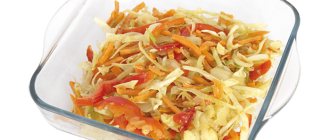Meat is a necessary element of the menu when breastfeeding. However, not every variety is recommended by pediatricians for a nursing mother to consume. Fatty foods cause stomach upsets, allergies and other problems in infants. Beef is considered the safest variety.
Already in the first week after giving birth, a nursing mother can consume beef broth. Then soups with vegetables, boiled, baked and stewed meat are introduced into the diet. In addition, veal, poultry and rabbit are allowed during lactation. But can a nursing mother eat pork?
Pork is a tasty and easy-to-cook meat, but pediatricians and nutritionists do not recommend consuming this product while breastfeeding. High fat content, cholesterol and lipids in the composition lead to negative consequences and digestive disorders for both mother and baby. However, if you know when and in what form to eat pork, the meat can also be consumed while breastfeeding.
Beneficial features
Pork contains fats and proteins that warm the body well, which is especially important in cold weather. Meat has a high energy value, gives strength and vigor, and increases tone. In addition, it promotes normal bone development in the baby. Thus. Pork performs a number of important functions in the body:
- Restores strength and fills the body with energy;
- Improves the functioning of the heart and blood vessels;
- Necessary for normal bone formation;
- Strengthens the bone skeleton;
- Improves mood and helps with depression;
- Normalizes hormonal balance;
- Prevents the development of anemia in infants;
- Increases hemoglobin levels, helps with dizziness and headaches.
Pork contains a large amount of B vitamins. These elements are responsible for normal metabolism in the body, restore and strengthen the structure of hair, nails and skin, and slow down aging. These vitamins are necessary for a woman’s speedy recovery after childbirth.
Diet for breastfeeding
There is an opinion that many foods should be avoided when breastfeeding. Sometimes, after friends tell you that after giving birth you will have to eat only buckwheat, and that pork is contraindicated during breastfeeding, the expectant mother panics and refuses to breastfeed her baby. But such an opinion does not have sufficient basis. A nursing mother must adhere to the following rules:
- Limit your diet for 1 month after giving birth. The child is very small, and it is not clear whether he suffers from allergic diseases or not. Therefore, during the neonatal period, preference should be given to hypoallergenic products.
- You can't stick to diets to lose weight. Such a diet will negatively affect the health of mother and baby. A deficiency of nutrients will affect the condition of hair, nails and skin.
- The volume of food should increase slightly. Just add a light evening snack.
- The basis is a varied diet without frills, food should be balanced.
- When introducing a new product, it is necessary to monitor the baby's reaction. If redness appears or the baby is naughty, you should discontinue the product for a while.
- Food must be high quality and natural.
Harm from pork
Pork is a very fatty and high-calorie food. In addition, it differs from other types of meat by the presence of a thick layer of subcutaneous fat and a high content of lipids and cholesterol. This is dangerous for human health, since consumption of such substances subsequently leads to heart attacks and strokes, and the development of atherosclerosis.
Pork negatively affects the functioning of the liver and kidneys. And high histamine content causes some inflammatory processes, skin and gallbladder diseases. Pork meat should not be consumed if you have problems with the gastrointestinal tract or kidney pathologies.
Pork can cause constipation in a baby or, conversely, diarrhea, bloating and colic. Low-quality meat becomes very dangerous for the baby and mother, it causes severe intoxication and can cause infection in the body. Therefore, if you decide to cook pork, it is important to choose high-quality and fresh meat.
The benefits of pork
Pork is rich in protein, which is the basis for the construction of new cells and growth of the child. The composition contains B vitamins and choline. Thanks to these components, the level of cholesterol in the blood is reduced, immunity is increased, the functioning of the nervous system is normalized, metabolism is enhanced, the skin and mucous membranes are protected from the invasion of infection.
Pork contains vitamins A, D, E, essential amino acids and minerals: iron, potassium, phosphorus, magnesium, sodium. 100 g of pork contains 24 g of protein, 11 g of fat, and the calorie content of lean pork is 160 kcal.
Due to the content of vitamins and minerals, pork benefits the body:
- efficiency increases, vital energy increases;
- has a beneficial effect on the nervous system, helps relieve fatigue;
- has a positive effect on the activity of the circulatory system;
- allows you to replenish milk deficiency and enhance lactation in women during breastfeeding;
- helps strengthen bones;
- strengthens the immune system.
Rules for eating pork during lactation
- According to the advice of doctors, pork can be consumed by a nursing mother no earlier than three months after the birth of the baby;
- Choose lean pieces, and lard should not account for more than 10% of the total mass;
- Eat pork only after prolonged heat treatment. When breastfeeding, you should not eat raw meat or meat with blood;
- The best dish for breastfeeding is boiled, stewed, baked or steamed pork.
- Limit the consumption of fried and grilled meat, barbecue;
- When breastfeeding, you can eat pork liver, as it is easily digestible and contains less fat;
- Eat pork in the morning;
- Try the pork broth for the first time. If the baby does not have a negative reaction within two days after the test, you can gradually introduce pork meat into the diet. To diversify the diet, add vegetables allowed during breastfeeding to the soup;
- If pork broth is not dangerous for the baby, you can introduce full-fledged meat. Start with a small piece of no more than 50 grams. If you have an allergy or stomach upset, delay introducing pork for a while. You can try again in a month;
- If the baby's reaction is normal, a nursing mother can eat pork no more than once a week. In this case, the daily norm is 100-150 grams. Remember that overeating while breastfeeding will negatively affect the baby’s well-being;
- Before cooking, rinse the meat thoroughly, remove fat and layers.
Authorized Products
If a newborn drinks breast milk, then the mother needs to get acquainted with the list of products that are allowed during breastfeeding:
- bananas and baked green apples;
- green and yellow vegetables (broccoli, cauliflower, zucchini, potatoes);
- non-carbonated drinks, dried fruit compote, juice (apple, pear, grape);
- baked, steamed meat (rabbit, turkey, chicken, beef, low-fat pork if breastfeeding);
- fermented milk products (kefir, fermented baked milk, yogurt, cheese, cottage cheese);
- lean white fish (pollock, blue whiting, flounder);
- porridge;
- bread;
- oil (vegetable and butter).
These foods should be in the mother's diet after the baby is born. In the first month, it is better to choose hypoallergenic components. In porridges, give preference to buckwheat, rice and corn, gradually adding other cereals. It is better to choose rabbit or turkey for meat; after 2 weeks, include beef, chicken and then pork.
How to choose and store pork correctly
It is important to choose young and fresh pork to avoid poisoning and other negative reactions in infants. High-quality meat has a pale pink or pale red color. To distinguish a fresh product from a defrosted one, press on a piece. If it returns to its original shape, the meat is good.
Carefully check the surface of the piece for stains. The pork should not have any defects except a small crust that appears after the meat dries. Pork should be firm and tender with a pleasant meaty smell without extraneous aromas.
Pork tenderloin is a dietary part of the carcass with minimal fat content, which is most suitable for a nursing mother. To prepare a broth or stew, you can use a pork shoulder, which is tough. The brisket is suitable for baking.
To preserve the flavor and nutrients of pork, it is important to store the meat properly. If you are using the product within the next two days, you do not need to place the meat in the freezer. During long-term storage, pork should be placed in the freezer. The shelf life is up to 3-4 months.
Before storing, be sure to clean the meat from packaging and small debris, but do not wash the carcass! Rinse meat immediately before cooking. For short-term storage, pork is placed in a container and covered with a lid so that there is access to air. For long-term storage, wrap the carcass in cling film or put it in a plastic bag.
Partially permitted products
A nursing mother should know the list of foods that are partially permitted during breastfeeding:
- 2-3 months after birth, you can include raw green or yellow vegetables, herbs;
- high-quality brewed coffee is allowed 6 months after the introduction of complementary foods;
- seafood with caution after 6 months;
- egg whites are introduced after 4 months, monitoring the child’s reaction;
- Do not abuse sugar and salt;
- bakery products in small quantities;
- semolina porridge and pasta 1-2 times a week;
- add whole milk to porridge or tea, do not consume it in its pure form;
- introduce cabbage soup and borscht in vegetable broth after 3 months;
- freshly squeezed apple juice after 1 month.
By following the lists of permitted and prohibited foods, a nursing mother will maintain the baby’s health and be able to eat well.
Recipes for dishes with pork for nursing
It is not recommended for a nursing mother to consume smoked and fried pork. When breastfeeding, you can eat steamed cutlets, baked pork with vegetables, vegetable soups with beef, vegetable stew with pork, and stew. When cooking soup or broth, it is important to drain the water after 4-5 minutes from the start of the process and pour new water.
Mayonnaise, hot seasonings and various sauces should not be used as a marinade or dressing. You can use soy sauce with caution while breastfeeding. For dressing and marinade, use sour cream, lemon, olive and sunflower oil.
We offer several simple recipes for delicious and healthy dishes with pork.
Stewed liver
- Pork liver – 400 g;
- Onion – 1 head;
- Garlic – 1 clove;
- Sour cream – 1 glass;
- Flour – 1 teaspoon;
- Milk – 100 g;
- Salt, herbs and vegetable oil.
First, remove the film from the liver. To speed up and simplify the process, you can lubricate the product with lemon juice. Then the film will be removed easily and quickly. Cut the liver and pour milk, which will soften the product. After half an hour, drain the milk and squeeze out the liver. Then simmer the pieces with chopped onions in vegetable oil for 8-10 minutes.
Separately, whisk the sour cream and flour, pour the mixture into a frying pan and simmer the liver for 20 minutes. Salt, add herbs, you can use parsley or dill. Simmer for another five minutes and stir occasionally. If the liver remains hard and the liquid has evaporated, you can occasionally add water.
Cooked liver goes well with rice and buckwheat, mashed and boiled potatoes, and pasta.
Pork with summer sauce
- Pork tenderloin – 4 steaks;
- Lemon – ½ piece;
- Olive oil – 4 tbsp. spoons;
- Garlic – 3 cloves;
- Salt, pepper and herbs (parsley and dill)
Lightly fry the steaks in olive oil, then immediately wrap in foil to keep them juicy and tender. To prepare the sauce, crush the garlic and chop the herbs. Mix the ingredients, add olive oil and the juice of half a lemon, salt and pepper.
Then remove the steaks from the foil and pour the sauce over them. Please note that this is a fairly fatty and difficult dish to digest, so do not overdo it with fried pork steaks.
Pork in cream sauce
- Pork tenderloin – 300 g;
- Sour cream – 1 glass;
- Onion – 1 head;
- Dill.
Cut the tenderloin into pieces and fill with water so that it covers the meat to a height of two fingers. Simmer for half an hour, then add sour cream and simmer under the lid for another half hour. 10 minutes before readiness, add chopped onion. Salt the finished dish and sprinkle with dill.
You will find even more healthy recipes for soups, salads, main courses and desserts for nursing mothers at the link /.
Subscribe to our VKontakte group
Three original pork recipes for nursing mothers and more
You can make a lot of delicious things from pork, but since smoked loin or jamon (cured pork ham) is still a risky food for a nursing mother, the author offers several more gentle ways to cook this meat so that it will be simply impossible to put down.
Buzhenina
This traditional dish is loved and known by everyone, but not every housewife succeeds in it.
Baked pork does not necessarily have to be fatty
At the risk of earning indignant criticism, I suggest using for this purpose not the traditional hip part of the carcass (back leg), but a cheaper shoulder (front leg). This meat is not so fatty and may even be a little dry, but the result will please you, believe me!
And now the recipe:
- So, the secret of real boiled pork is in pre-marinating the meat. You can use a dry marinade: rub the pulp with spices and seasonings, cover and leave in the refrigerator for 5–8 hours. But my friend does it differently, and it’s very tasty. A very saturated salt solution, literally brine, is prepared in advance (don’t be afraid to oversalt, the meat will take as much salt as it needs, feel free to put 2-3 tablespoons per liter of water).
- Water and salt are brought to a boil, mixed well until the salt dissolves, then any herbs and spices are added to it: be sure to use bay leaves and peppercorns, the rest is to your taste. You can choose the composition yourself, or use ready-made mixtures (for example, Provencal herbs). Do not overuse chili pepper; eating too spicy food is not advisable for a nursing mother.
- Let the aromatic solution cool and pour it over the meat so that it is completely covered. If you need to speed up the process, leave the spatula to stand at room temperature for at least a couple of hours, but it is better to put the pan in the refrigerator overnight. The aromatic marinade will not only saturate the meat and make it more tender, but will also “pull out” from it a significant part of the harmful substances that are present there thanks to unscrupulous manufacturers, that is, everything that is especially dangerous during the period of breastfeeding.
- And now - the most important thing. Gently wipe the meat removed from the marinade with a paper towel, wrap it in foil (the more layers are used, the better) and put it in the oven, preheated to 140-150°C, where the boiled pork will be baked... for four to five hours. It is long cooking on minimal heat that will make the meat divinely tender!
- Half an hour before cooking, cut the top layer of foil and increase the temperature to 200 °C so that a golden brown crust forms on the surface of the meat.
In this form, the meat is stewed for a very long time on minimal heat.
The shoulder blade prepared in this way can be consumed both hot and cold, in both versions the meat literally melts in your mouth!
Salted lard with garlic
Not a single Ukrainian can imagine his life without this product. One can laugh at such a national feature, but anyone who has tried real Ukrainian lard knows how tasty it is.
Salo makes life brighter
Lard can be prepared in different ways, but we will offer a recipe that does not involve heat treatment. Correctly maintained technology and high-quality raw materials eliminate poisoning, but a woman who is breastfeeding should pay special attention to these two factors.
Choosing the right lard is a whole science, so if you don’t have enough experience, it’s better to take an “understanding” person with you to the market. In any case, a good lard for pickling should be:
- medium thickness (it is better to bake thin lard into a roll, but thick lard will not be salted well), aim for 5 - 6 cm;
- with a thin skin (if the skin is dark in color, it means it has been tarred, such lard can be taken);
- pinkish color (a sign of freshness);
- without meat streaks or with a minimal amount of them (this is tasty, but too dangerous for a recipe without heat treatment).
Next follow the instructions:
- Cut the selected lard into cubes 10-12 cm long and 6-7 cm wide.
- Using a sharp knife, make several cuts in each piece to a depth of 2-3 cm and insert a peeled clove of garlic into each “pocket”. If the garlic is large, cut the cloves in half lengthwise and use the halves, this will make the lard even more flavorful.
- Place pieces of lard stuffed with garlic tightly into a glass jar and fill it to the top with pre-prepared brine, cooled to room temperature.
To prepare the brine, you need to take coarse salt at the rate of 4 heaped tablespoons per 1 liter of water, heat until the salt is completely dissolved, add a few black peppercorns and 3-4 bay leaves. Nothing more is needed, excesses in this case will only do harm!
Don't forget to stuff the lard with garlic!
All that remains is to put the jar of lard in the refrigerator and wait three days (in the case of a nursing mother, add a couple more days to be on the safe side). After this, the product is ready for use, but it must still be stored in brine, otherwise the lard will quickly “age”.
By the way, the author is one of the gourmets who believe that salted lard should be eaten only with the skin, but a nursing mother should still cut off this part as the least healthy. Surely there will be someone in the family who will not let the product go to waste.
Recommendations for the consumption and selection of pork for nursing
- It is best to eat the so-called pork tenderloin. Although it is much more expensive than meat from other parts of the carcass, it is here that the amount of fat is minimal.
- Meat must be thoroughly boiled, baked or stewed before being eaten. This is the only way to protect yourself from poisoning or getting any parasites into your body.
- Fried and smoked meat should not be consumed during breastfeeding.
- In some stores you can find meat from piglets, not adult pigs. This product is also characterized by high fat content, and therefore it is better to avoid it during lactation.
Rules for storing meat products
Any product will be useful only if it is properly stored.
This rule also applies to pork. If store-bought meat is not used immediately, it is advisable to use it in the next two days. The product can be stored in the refrigerator on the top shelf for the entire specified period. If the storage time increases, then you need to place the meat in the freezer. There it can be stored for no more than three months. Moreover, defrosting and then freezing meat again is strictly prohibited.
Before placing it in a low-temperature chamber, the meat must be thoroughly cleaned of debris and the packaging removed. Under no circumstances should it be washed. Pork is washed before cooking. For short-term storage, it is wise to use a container with a lid to prevent microflora and air from reaching the surface of the product. Alternatively, you can wrap a piece of meat in cling film.
By following these simple recommendations, all risks will be minimized and the benefits from the product will be maximized.
Is it possible for a nursing mother to have chicken liver?
Can a nursing mother eat pork?
First, let's look at the main question of the article - is it allowed to include pork in the diet of a nursing mother? The answer to this is unequivocal - yes, but this particular type of meat is quite specific, and therefore this issue requires a more detailed consideration.
Beneficial properties of pork
If we talk about which red meat is the most common in our world, then pork will undoubtedly be in first place. This is not surprising, since this animal has a large amount of meat tissue, which is considered one of the best sources of proteins.
Pork contains many vitamins, minerals and amino acids that have a positive effect on human health, of course, if the meat is consumed within reasonable limits. It is thanks to this abundance of beneficial nutrients that pork meat has a beneficial effect on the functioning of many systems in the body and improves their functioning.
Pork regulates blood pressure
This meat is a rich source of potassium; when this substance enters the human body, it interacts with sodium, which normalizes blood pressure. Changes in blood pressure are quite common among young mothers, and therefore this feature makes pork very useful in such a situation.
Meat avoids damage to blood vessels and reduces the risk of developing serious diseases associated with blood pressure disorders.
Beneficial effects on the cardiovascular system
Although it is widely believed that pork, on the contrary, aggravates the condition of this system of our body, this is only partly true. Only improperly cooked meat can cause damage to the heart, this is especially true for pork fried in vegetable oil - in such a dish the amount of trans fats is incredibly high.
If you eat pork no more than twice a week, its beneficial effect on blood pressure will be an excellent prevention of many cardiovascular diseases.
High protein content
As you know, proteins are the main building material that babies use for growth and development. Pork is one of the most protein-rich meats.
Thanks to the adequate supply of proteins with mother's milk to the baby's body, his active weight gain and intensive development of all parts of the body occur.
Large amount of nutrients
Pork is rich in nutrients that are essential for energy production and rapid recovery. They support the physical activity of both mother and baby, increase overall energy levels and help actively fight fatigue.
Brain development and bone strengthening
Pork contains quite a large amount of phosphorus and calcium. These microelements are necessary for the maintenance and development of brain function, as well as strengthening bone tissue.
In the first year of a baby’s life, its most intensive growth occurs, and therefore the need for these compounds is increased.
Vitamins and fatty acids
Pork contains omega-3 fatty acids and B vitamins. The beneficial qualities of these substances for human health have long been proven, since they are involved in many vital processes. They are especially necessary for growing children.
How to introduce pork tongue into a nursing diet
If the child is healthy and developing normally, you need to diversify your diet with new foods. If you love pork tongue and decide to try it for the first time after giving birth:
- Choose the first half of the day for this, so it is more convenient for you to observe the reaction of the baby’s body;
- Eliminate the possibility of consuming other new products during this and the next 1–2 days;
- For the first time, it is recommended to limit yourself to a small slice of boiled tongue.
Over the next two days, monitor your baby's condition. You will have to postpone introducing a new product for a while if your child develops:
- Rash, redness or any dermatological manifestations;
- Disturbances in the normal digestion process, changes in the appearance and color of stool;
- The appearance of excess gases in the intestines.
If your baby's condition worries you, be sure to consult your pediatrician.
Salo and shish kebab
Shish kebab is a favorite pork dish, traditionally prepared in spring and summer. Should mom refuse it or can she eat a piece?
It is not advisable to consume pork shish kebab while breastfeeding. Fats and carcinogens contained in charcoal-grilled meat will negatively affect a child’s digestion, especially in the first 3 months of his life. Sauces and marinades served with the dish can cause poisoning.
Excess fat and high calorie content provoke constipation and intestinal colic in a child. Marinades made from mayonnaise, onions, and garlic, in which meat is soaked, are contraindicated during breastfeeding.
Overcooked meat will cause abdominal pain in a child, while undercooked meat will cause indigestion or the occurrence of infectious diseases.
If mom chooses the right marinade and cooks the dish well, then sometimes you can allow a couple of pieces of pork. It is best to eat shish kebab with stewed vegetables. Use kefir or mineral water as a marinade, a small amount of salt and herbs is acceptable. During the cooking process, you need to monitor the readiness; it is best to cut the meat into small pieces and bake on a wire rack.
It is better for a woman who is breastfeeding to avoid lard. Excess fat will not benefit the baby or mother. But if mom really wants salted lard, then after 6 months you can eat a small piece. Smoked lard is strictly prohibited.
Harm or why pork should not be eaten when feeding newborns
However, this meat also has a number of harmful qualities, and they are quite serious. It is because of these features that pork is so often classified as undesirable and even harmful products, here are the main ones:
- Special methods of processing pork - smoking, frying, and so on - cause the formation of so-called carcinogens in the meat. According to WHO, it is processed pork meat that very often causes cancer.
- Quite often, pork meat contains large amounts of toxins . This usually occurs if the animal has taken additives for accelerated growth, which lead to the stagnation of harmful substances in the pig’s body and in its meat.
- Various parasites are the most common in pork That is why it is very important to subject the meat to thorough heat treatment.
- If pork was cooked with a large amount of fat , then such meat can cause problems with the heart and blood vessels, as well as cause diseases such as atherosclerosis, stroke or heart attack.
- Traces of antibiotics can be found in some meat - such drugs are used by unscrupulous pig farmers to prevent animal diseases.
- Sometimes eating pork by a nursing mother can cause digestive problems in the baby, which are expressed in bloating, colic and constipation.
As you already understand, the most important condition when eating pork is choosing it correctly. Only a fresh and high-quality product from a large, trusted manufacturer can guarantee the absence of the dangerous properties described above.
But even a completely pure product can cause an undesirable reaction in a child, and therefore it is important to know how and in what quantity you should introduce pork into your diet.
Recipes for breastfeeding
You can eat pork in limited quantities while breastfeeding. Recipes for cooking can be different:
- Stewed pork with vegetables. Place pork without fat in a slow cooker or stewpan and add a little water; after the meat is stewed until half cooked, add zucchini, cauliflower, carrots, potatoes and salt. It is necessary to simmer over low heat until cooked.
- Pork cutlets. When breastfeeding, it is necessary to carefully remove fat from the meat and grind it in a meat grinder. It is not advisable to buy ready-made minced meat. You can add raw grated potatoes to the cutlets. This way the dish will become less fatty.
- Potato soup. Lean pork is boiled and cut into pieces. Coarsely chopped potatoes, carrots and onions are added to the broth. Cook until done.
Which meat do you prefer?
Nutritionists have long recognized beef as the safest meat that a woman can eat without fear for the health of the baby.
In the first week after the birth of the baby, you are allowed to consume only broth, but later you can diversify the diet with second courses. The method of preparing them is important. Experts recommend stewing or baking beef meat, but you can steam it. In addition to beef, you can base your diet on other dietary varieties of meat products: poultry, veal, rabbit. Although pork has a pleasant taste and is easy to cook, due to the high fat content of the product, it is not advisable for mothers to consume it, especially at the initial stage of breastfeeding. This meat has a high content of lipids and cholesterol, which can cause constipation in the baby and the woman herself. And such food will not have the best effect on your figure. Therefore, in the first months of feeding your baby, you should still refrain from consuming such a high-calorie product. But in the later stages, such meat can completely diversify the diet.











